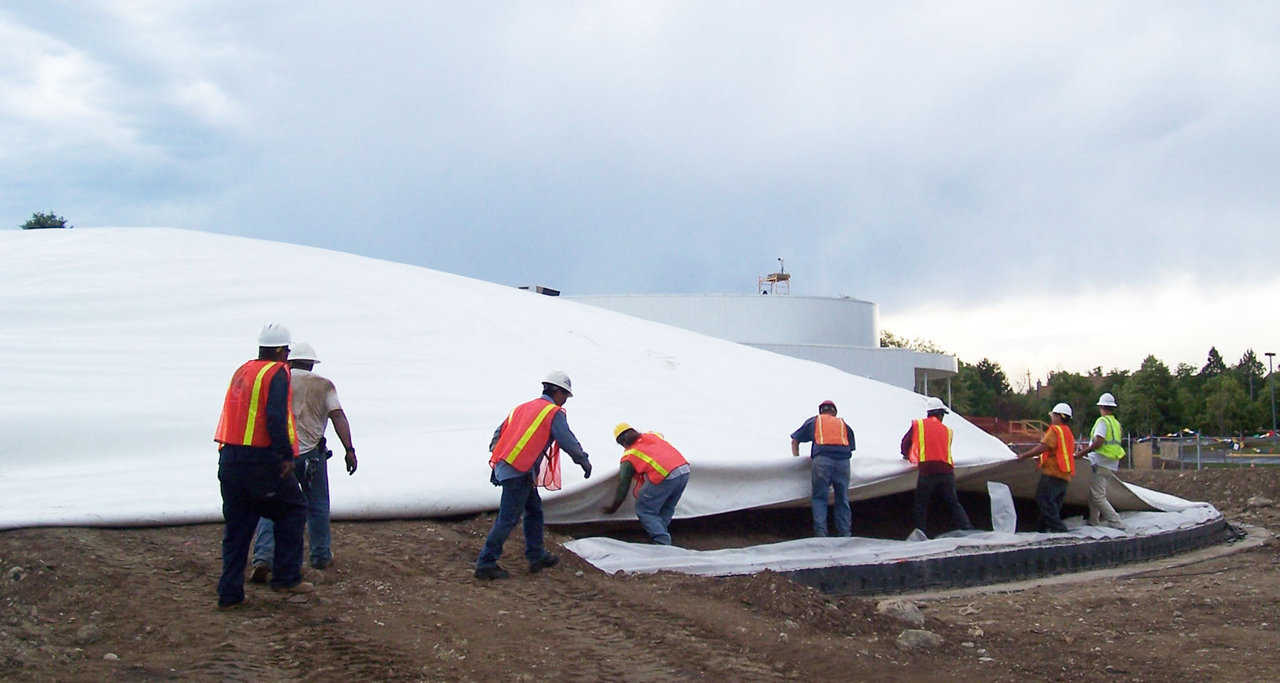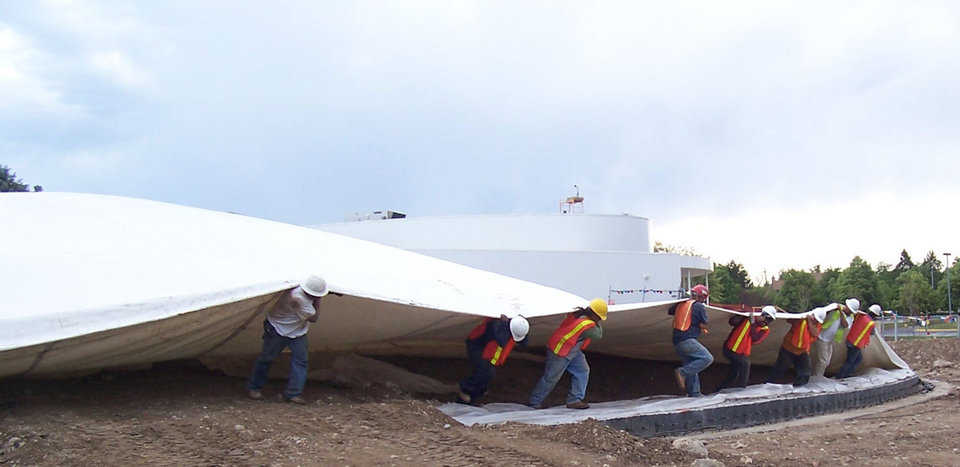Airform = highly engineered fabric structure
Because of the expense of the Airform, extreme care should be taken not to damage it. The most likely time to damage the Airform is while transporting it to the job site; spreading it; attaching it; and inflating it.
Great care is taken to allow for the stretch factors in the Airform and for any other anomalies, so the building inflates to its proper shape. Obviously it is an inflated building, and obviously it is impossible to predict precisely the shape of the structure. Therefore, it is important that allowances be made for a slightly larger or a slightly smaller structure.
Handling the Airform
Avoid using sharp instruments against the Airform itself. Pliers should not be used on the Airform. It’s very handy for a worker to grab the Airform with a pair of pliers. This creates a weak spot and is not a good practice. It will not create a disaster, but nevertheless is not a good idea.
Forklift operators should be cautioned not to accidentally poke the forks of the forklift into the Airform. This causes a great deal of grief since it creates holes in many places in the Airform.
Unrolling the Airform
The Airform should not be unrolled over sharp objects. Most Airform materials have a thick side and a thin side. The thick side is the smooth side and the thin side is the rougher side. Keep the thick side to the weather. This protects the threads from the sun.
It is imperative that the Airform be spread evenly around the footing. This can only be done by measuring the footing carefully and marking it into sections that correspond to sections marked on the Airform. Never just pull it on like an old sock. If the Airform is not spread evenly it can create a great amount of strain in the wrong areas and destroy the Airform.
Airforms are lifted with air pressure. So guess what? They are much easier to move on the jobsite if they have a layer of air under them. Use the main inflator units or auxiliary fans to induce air under the Airform. With a layer of air under the Airform, it can be easily “slid” into place. This eliminates the need to pull with equipment.
Pulling on the Airform with equipment may result in snags and tears and may void the warranty. Use Air. A fabric tube attached to the inflator or a grain dryer fan with tube are simple ways to induce air under an Airform as it is spread.
Fastening the Monolithic Dome Airform
- Count the number of gores around the Airform. Label them on the seams with a ballpoint pen. Start with zero.
- When you have an accurate count of the gores, measure the actual distance around the foundation. Divide the perimeter by the number of gores and then mark with a heavy marker on the foundation where each of the gores goes. This may be done on every third gore, or just the master gores, depending on the size of the dome.
- The Airform should be laid out over the foundation. The entire circumference of the foundation should be covered evenly. The gores should fit the marks on the foundation.
- Be sure you attach the Airform on one side, then its opposite. Then attach the quarter points, and their opposites, and continue evenly all the way around. If you start at one place and go all the way around, you will be wrong almost every time. The Airform will stretch to fit the foundation tightly.
We need to know if it fits perfectly or imperfectly. We are constantly working on this technology. We need your feedback and help in perfecting the engineering and manufacturing.
Inflating the Airform
Once the Airform is in place, bolted down, and thoroughly inspected, it can be inflated.
NOTE: The measurement of air pressure referred to here will be inches of water column (WC). This is the amount of air pressure differential needed to raise water in a column.
The inflating should NOT be done in strong winds. The Airform is most vulnerable when it is partially inflated. A time should be selected for the inflating when the winds will be at a low point – less than 10 to 15 mph. Less than 5 mph is certainly most desirable.
The inflating usually takes less than 30 minutes on small buildings. During the time of inflating it is absolutely essential that inspecting continue. The inflating procedure should follow these guidelines:
- The inflator fans are started and the Airform inflated. The air pressure should be regulated. When the Airform first becomes tight, the inside air pressure will be at a minimum (about one to two-tenths of one inch).
- The Airform should then be checked for weak spots, holes, etc. The Airform tie-down should then be completely checked.
Repairs to the Airform
Repairs can be divided into three kinds. First is purely cosmetic. The second is necessary, but non-structural, and the third is structural. We’ll try to cover each one individually.
Repair of nicks and scrapes can be done simply by heat welding on a patch. A “patch” is the word we use but the process is to apply a piece of the same Airform material to reinforce and close any tears, openings, or thin spots.
If the repairs can be made from the back side, this is preferable because it is less noticeable than from the front side. If for some reason the back side is not available, then care should be utilized to make a patch no bigger than is necessary. Usually the patching material should reach two inches beyond whatever the repair is. If you repair a hole, go two inches in all directions.
We recommend applying the patch by heat welding it in place. Heat welding can be done by anyone with the equipment and the knowledge. What is required is a specially designed electric heat gun that provides the heat source. These units are usually owned by single-ply roofing companies as well as Monolithic. The repairs are made by melting the two materials and rolling them together with a silicone covered roller.
Structural repairs are necessary if large pieces have been damaged either by mishandling or a storm during inflation. These tears may be relatively small, in which case they are probably not too big of a problem. Or the damage may be as extreme as having the Airform split into three sections. High winds will induce an extremely high lift to an inflated Airform. If an Airform “pops” under high winds it usually tears three lines, from top to bottom.
A most major repair could necessitate sending an Airform back to the factory. This is not generally necessary unless field conditions dictate this as a solution.
Very satisfactory repairs can be made in the field even to catastrophic rips. This is usually accomplished by butting the torn material together and using a 4- to 8-inch wide repair strip to cover the butt joint. Obviously the joint will show less if the strip is on the underside, but a repair will work equally as well from either side.
Note: This article was updated in July 2007.

